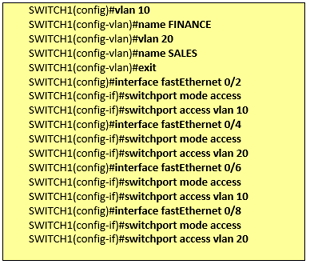We hope you are enjoying our CertificationKits CCNA Blog series and it is giving you great insight into how to prepare for your Cisco CCENT or CCNA exam. In this series we are covering a variety of real world scenario type questions that you could see on your exam. These are not simple memorization questions which can be memorized from a CCNA brain dump site. These questions go in-depth and actually teach you the theory of how to read an exam question and how to eliminate the tricky answers that you might otherwise pick by mistake. So let’s jump into today’s CCENT/CCNA exam question which actually covers multiple topics. You will need to fully understand how VLANs work, how to subnet and how the ICMP protocol works during a ping. Lots of neat stuff!
So the first thing we are going to look at is the configuration that a junior network operations center associate put on a Cisco switch. You are going to want to refer back to this switch configuration as you also review our host, ip address and port assignments.

The list shows the IP address assignments on four PCs in the company as well as their corresponding port assignments. Which of the statements is true?
| HOST NAME | IP ADDRESS | Port |
| HostA | 192.168.1.34/28 | Fa0/2 |
| HostB | 192.168.1.49/28 | Fa0/4 |
| HostC | 192.168.1.46/28 | Fa0/6 |
| HostD | 192.168.1.35/28 | Fa0/8 |
A. HostB can ping HostD
B. HostA can ping HostC
C. HostA cannot ping HostB and HostD
D. HostC cannot ping HostD
E. HostA can ping HostD
F. HostB cannot ping HostC but can ping Host D
This is very similar to the type of question you will see on your CCENT or CCNA exam. So the more practice you can get with these complex questions the better your chances are of passing your exam! Now if you do not know the answer off the top of your head, we will give you a little bit of a hint as we go over some high level concepts on VLANs and port assignment. If you are really weak with VLANs, you can review our in-depth article on VLANs here.
VLANs are useful in segmenting switches into different broadcast domains. And logically separates users into groups, which adds security. However, for users on the same VLAN to communicate, they must be in the same subnet. The VLAN MUST correlate to the subnet, each VLAN has its own subnet. This question tests the understanding of subnetting and VLANs as well as port assignments.
So are you ready for the answer?
The answer is B, C and D. So let’s review the explanations for each of the possible answers below.
A. HostB cannot ping HostD because even though they are in the same VLAN, the IP address on HostD is in the wrong subnet.
B. HostA can ping hostC because they are both in the same VLAN and also their IP addresses are in the same subnet which has been assigned to VLAN 10
C. HostA cannot ping HostB and HostD. This is because HostB and HostD are in a different VLAN
D. HostC cannot ping HostD because they are in different VLANs
E. HostA cannot ping HostD because they are in different VLANs even though their IP addresses are in the same subnet.
F. HostB cannot ping either hosts because HostC is in a different VLAN and HostD is in a different subnet even though they are in the same VLAN.
Hopefully seeing questions like this gives you a better appreciation for the difficulty of the CCENT and CCNA exams. They are not a walk in the park. You really need to understand TCP/IP well and how to pull together multiple concepts to arrive at an answer. This is where a real CCENT or CCNA lab really comes in handy. By having the ability to test these concepts out and see them in action really helps to burn the theory into your brain. So feel free to review our CCNA Lab Suggestions page to get suggestions on how to build your own CCNA lab.
If you are still not sure of how to approach it, feel free to contact us and we will be happy to help you out.
